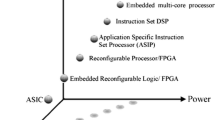Abstract
This paper presents an evaluation of rate control algorithms from a system-level VLSI design viewpoint. Rate control in video coding has a significant influence on the coded bit rate and image quality. Many rate control algorithms have been proposed mainly focusing on the optimal rate-distortion performance without considering their performance on the VLSI implementation. The purpose of this study is not to propose a hardware architecture for any specific algorithm but to study the algorithm impact on hardware design. Based on our finding, a system designer should choose an algorithm not only good in rate control performance but also good in hardware implementation. When implementing and comparing a few rate control algorithms using a generic processor structure, we found that, in addition to the ordinary computational complexity, the internal buffer size is also very critical in VLSI realization. Several picture sequences have been tested including one sequence constructed specifically to simulate a difficult case for rate control. In this paper, three different types of popular rate control algorithms have been analyzed based on their picture quality, the internal buffer size, and the hardware cost. The methodology and results presented here provide useful guidelines for selecting an appropriate rate control algorithm for system-level VLSI designers.
Similar content being viewed by others
References
K. Kucukcaker and A.C. Parker, “A methodology and design tools to support system-level VLSI design,” Tech. Rep. Department of Electrical Engineering-Systems, University of Southern California, June 1994.
ISO/IEC JTCI/SC29/WG11 MPEG phase 2, Doc. NO400, “Test Model 5,” April 1993.
S.-C. Cheng and H.-M. Hang, “The impact of encoding algorithms on MPEG VLSI implementation,” IEEE Int. Conf. on Circuits and System, 1998, to appear.
S.-C. Cheng and H.-M. Hang, “A comparison of block-matching algorithms mapped to systolic-array implementation,” IEEE Trans. Circuit Syst. Video Technol., Vol. 7, pp. 741–757, Oct. 1997.
A. Puri and R. Aravind, “Motion-compensated video coding with adaptive perceptual quantization,” IEEE Trans. Circuit Syst. Video Technol., Vol. 1, No.4, pp. 351–361, Dec. 1991.
CCITT, Working Party XV/4, Doc. 525, “Description of Ref. Model 8 (RM 8),” June 1989.
K.-W. Chow and Bede Liu, “Complexity based rate control for image encoder,” Int’l Conf. on Image Proc.’ 94, Vol. 1, pp. 263– 267, Nov. 1994.
W.-Y. Sun, H.-M. Hang, and C.-B. Fong, “Scene adaptive parameters selection for MPEG syntax based HDTV coding,” Int’l Workshop on HDTV’ 93, Ottawa, Canada, Oct. 1993.
J.-B. Cheng and H.-M. Hang, “Adaptive piecewise linear bits estimation model forMPEGbased video coding,” Visual Commun. and Image Represent., Vol. 8, No.1, March 1997.
Y. Shoham and A. Gersho, “Efficient bit allocation for an arbitrary set of quantizers,” IEEE Trans. ASSP, Vol. 36, No.9, Sept. 1988.
K.M. Uz, J.M. Shapiro, and M. Czigler, “Optimal bit allocation in the presence of quantizer feedback,” Proceedings 1993 Internal Conference on Acoustics, Speech and Signal Proceeding, Vol. 5, pp. 385–388, 1993.
K. Ramchandran, A. Ortega, and M. Vetterli, “Bit allocation for dependent quantization with application to MPEG video coders,” Proceedings 1993 Internal Conference on Acoustics, Speech and Signal Proceeding, Vol. 5, pp. 381–384, 1993.
W.-Y. Lee and J.-B. Ra, “Fast algorithm for optimal bit allocation in a rate distortion sense,” Electron. Lett., Vol. 32, No.20, Sept. 1996.
P. Pirsch, N. Demassieux, and W. Gehrke, “VLSI architectures for video compression–A survey,” Proc. of the IEEE, Vol. 83, No.2, Feb. 1995.
Texas Instruments, 2547301-9721, rev. D, “TMS320C5x user's guide,” Jan. 1993.
T.S. Chang, “On-chip memory module designs for video signal processing,” Master thesis, Institute of Electronics Engineering, National Chiao-Tung University, Hsinchu, Taiwan, ROC, June 1995.
Author information
Authors and Affiliations
Rights and permissions
About this article
Cite this article
Cheng, SC., Hang, HM. The Impact of Rate Control Algorithms on System-Level VLSI Design. The Journal of VLSI Signal Processing-Systems for Signal, Image, and Video Technology 20, 233–250 (1998). https://doi.org/10.1023/A:1008030931864
Published:
Issue Date:
DOI: https://doi.org/10.1023/A:1008030931864




